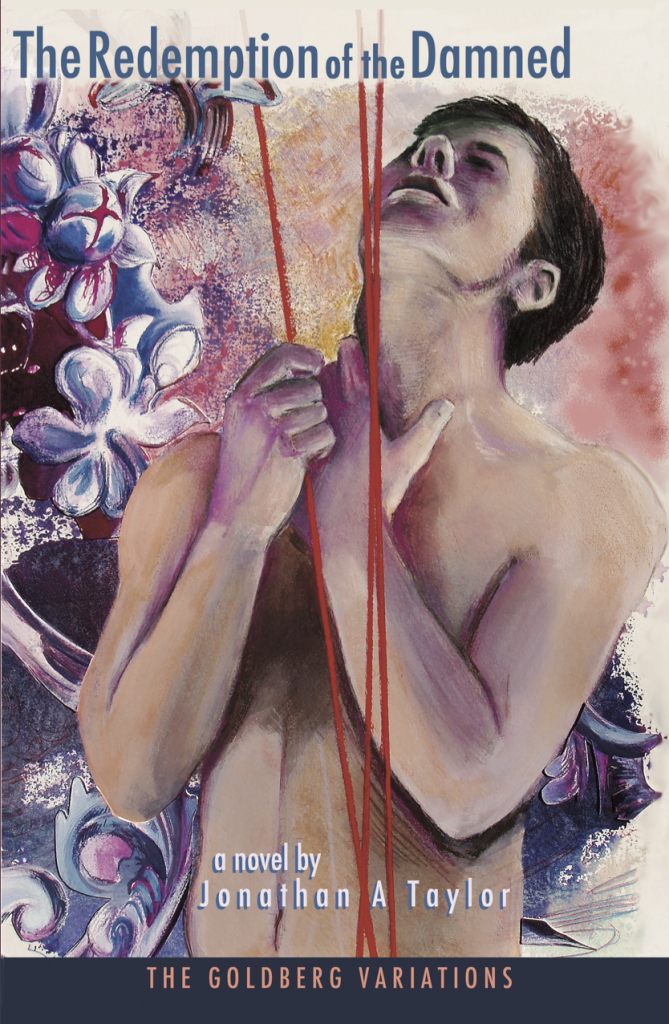Fractured Reflections:
A Symphony of Desire and Self-Reckoning

Synopsis of The Goldberg Variations: Redemption of the Damned
Jamie Goldberg, newly out of the closet in 1980 Detroit, thinks coming out of the closet will solve his problems, but darker secrets remain. He cannot seem to face these traumatic secrets let alone accept them. He discovers that human sexuality is a lot more complex than merely gay versus straight. He experiences profound societal pressures, parental rejection, and social alienation after openly admitting he is gay. But he also learns that his struggles with sexual acceptance, low self-esteem, and suicidal thoughts only begin with coming out. In short, he realizes that coming out of the closet can pose more problems than it solves. Sometimes he is sustained only by his own wry sense of humor; other times he is sustained by music, theater, and ultimately by a cast of Detroit characters who accept him as he is even if he does not. Ultimately, he has a date with his past he cannot escape. That confrontation threatens to damn him or possibly redeem him.
Although The Redemption of the Damned is intended to stand alone, it is part of a multi-volume work called The Goldberg Variations. It is the successor volume to The Rites of Passage. This series follows its main character on a journey of self-discovery through an odyssey of trials, errors, and the occasional moment of grace leading this main character, Jamie Goldberg, on his elusive journey to discovery, redemption and self-actualization. This journey takes him to many places while meeting a diverse cast of characters along the path to his own surprising, quirky self-discoveries.
Kirkus review for Volume 2: Redemption of the Damned
A powerful tale of one young man’s sexual awakening.
A sequel focuses on a gay student coming into his own in early 1980s Detroit.
After an adolescence filled with fear and self-loathing, Jamie Goldberg has finally decided to come out of the closet. The college student chooses to do so the Sunday after Thanksgiving 1980 in the kitchen of his parents’ home in Northwest Detroit. “There,” narrates Jamie ruefully, “homosexuality scored another decisive yet Pyrrhic victory.” Despite his mother’s lifetime of involvement in progressive politics, she reacts with anger and disgust. His father asks him to leave, telling him, “Don’t come back until you’re cured.” Now that his parents are no longer paying for school, Jamie switches to his preferred major, theater, and throws himself into the work. He begins to experiment with his newfound freedom, but he still has concerns with the way others perceive him as well as learning hard lessons about love and sex. Jamie begins to develop a reputation for promiscuity after an incident involving his crush, Casper Tyres, and he starts to explore—sometimes willingly, sometimes not—the world of cruising. In certain bathrooms and parks, with acquaintances and strangers, Jamie finally becomes intimate with the peculiar and often frightening world of male sexuality. It’s made all the more difficult by the fact that he still has not yet reckoned with the act that initiated his sexual life: the rape he suffered as a young boy. As Jamie’s sex life quickly escalates to new heights, he realizes that he hasn’t found himself by coming out of the closet. In order to realize who the real Jamie Goldberg is, he still has a lot of work to do.
Taylor’s prose is smooth and often striking, creating memorable images that will stick in readers’ minds as much as they do in that of the impressionable Jamie: “We got in this old boat-like white Cadillac and drove down Woodward. Detroit, that late at night, resembled a demilitarized zone after curfew. Stores with thick metal bars; offices with small if any windows, protected by iron rails; and the occasional empty burned-out lot left exactly as it was after the 1968 riots.” The author skillfully portrays Jamie’s claustrophobic sense of himself in the world, beset on one side by the homophobia that constantly threatens his well-being and on the other by the lusts of men who do not have his best interests at heart. Between this rock and a hard place, Jamie festers in a stew of confusion and self-disgust. The book has a narrower time frame than the previous volume in the series, covering only a six-month period from 1980 to ’81. While the condensed period helps make the tale more palatable, there is still just too much of it. At over 400 pages, the book is bloated by superfluous scenes and redundant episodes, feeling more diaristic than novelistic on occasion. Taylor succeeds in capturing a time and place in Jamie’s life, but the story would likely have had a greater impact if the author had managed to show less of it.
A powerful tale of one young man’s sexual awakening.